I was gifted a decent sized wood recently, after a local had seen a grey squirrel, and my good friend, Shaun, who was at full capacity with the other permissions he tended, passed the land on to me. That single sighting has turned into a full-scale air attack, and even featured in a recent Shooting and Country TV episode. The greys just kept coming, and that single sighting has turned into 40-plus skinnies being taken out of the wood.
My trail cams are checked every few days, to keep updated with the latest movements and quantities, and some great news is that we now have reds in good numbers showing HUNTING on all the feed stations, and even better … they have bred and have youngsters with them.
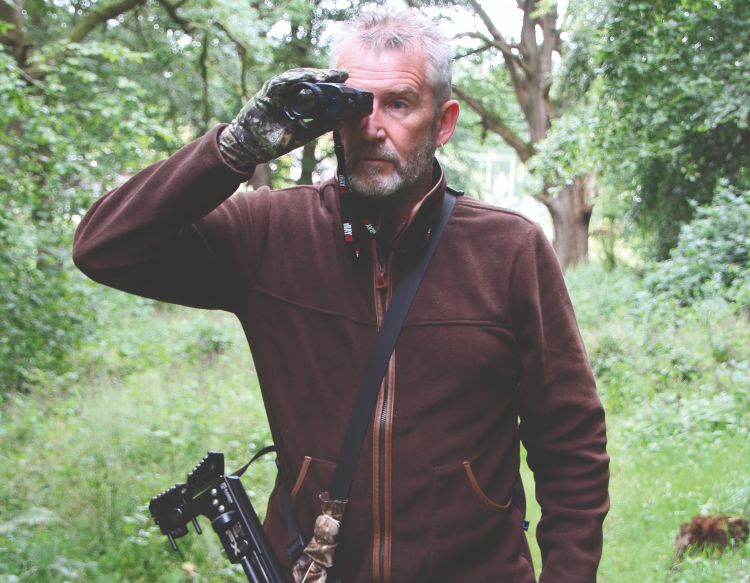 Scanning the track ahead with the thermal could bring a bonus skinny or two.
Scanning the track ahead with the thermal could bring a bonus skinny or two.
It’s a great sight, from the comfort of the hide, to be able to watch the young reds at play under the watchful eye of the adults, to see how they learn how to feed from the feeders and how they have grown. They are now starting to make their own way in life … stretching the boundaries of exploration and eventually settling down in another part of the wood, just in time for the process to start all over again with the next litter of kittens. This breeding starts in June/July, the litter being born around 45 to 48 days later with » an average of three new-borns, but it’s not too unusual to have more. So, along with the reds I’ll be expanding my boundaries to keep in touch with the ever-growing families … more on that shortly, but first a little background info on the red/grey situation.
HIGHLY VULNERABLE
When born, the red squirrel is blind, has no teeth or hair and its ears are closed, this is the time of high vulnerability because disease and predators, including birds of prey and other carnivores, would not hesitate to take advantage of this vulnerability. Although it’s thought that grey squirrels don’t actively hunt and eat red squirrels, it has been reported that greys have been seen eating songbird eggs and chicks, so with that in mind, it’s fair to assume that they would take young reds if the opportunity arose.
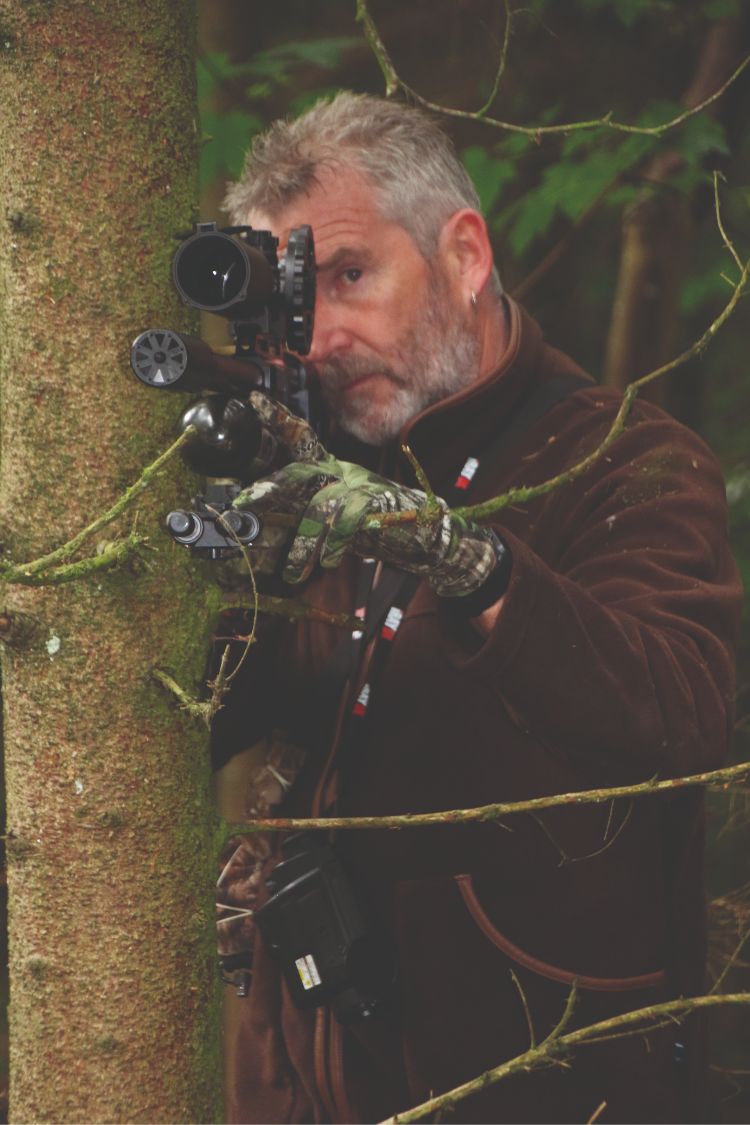 Surprise ferals on the scatter feed were dealth with appropriately, with help from the pine trees
Surprise ferals on the scatter feed were dealth with appropriately, with help from the pine trees
The adult red squirrel will move dreys if it fears being found by predators, or other reasons, including damage to the drey, infestation of fleas or even being waterlogged. So, the reds are a great parent and look after their young wholeheartedly, but they cannot protect against the squirrel pox that is passed on by the grey squirrel, and this is where we come in – ‘we’ being the nations pest controllers.
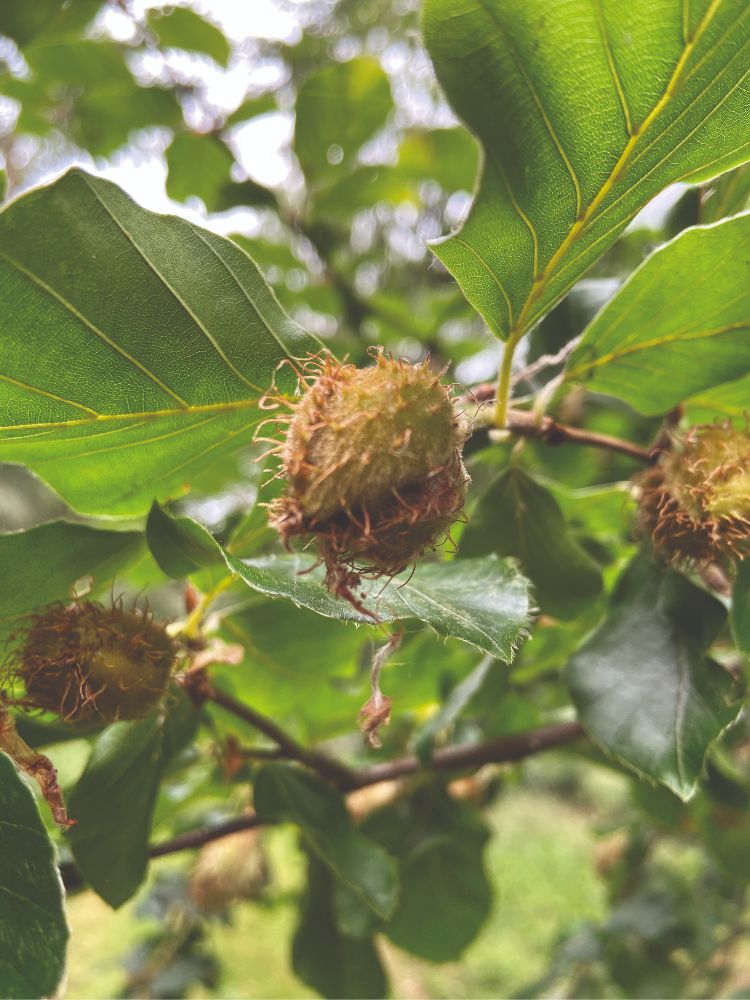 Looks like being a bumper year for the beech mast
Looks like being a bumper year for the beech mast
The greys were introduced to the UK in the 1800s during the Victorian era and the numbers are now thought to be around 2.5 million, whereas the reds are estimated to be a lowly 140,000 – a huge difference and an obvious threat to the livelihood of the native red. It is thought that without the extremely hard work of the many conservation groups up and down the country, the red squirrel would be completely eradicated within 10 years, and I fear it could be less than that. Our work is important and I don’t mean just squirrel rangers, but every pest controller and supporter in the UK – ‘Your reds need you!’
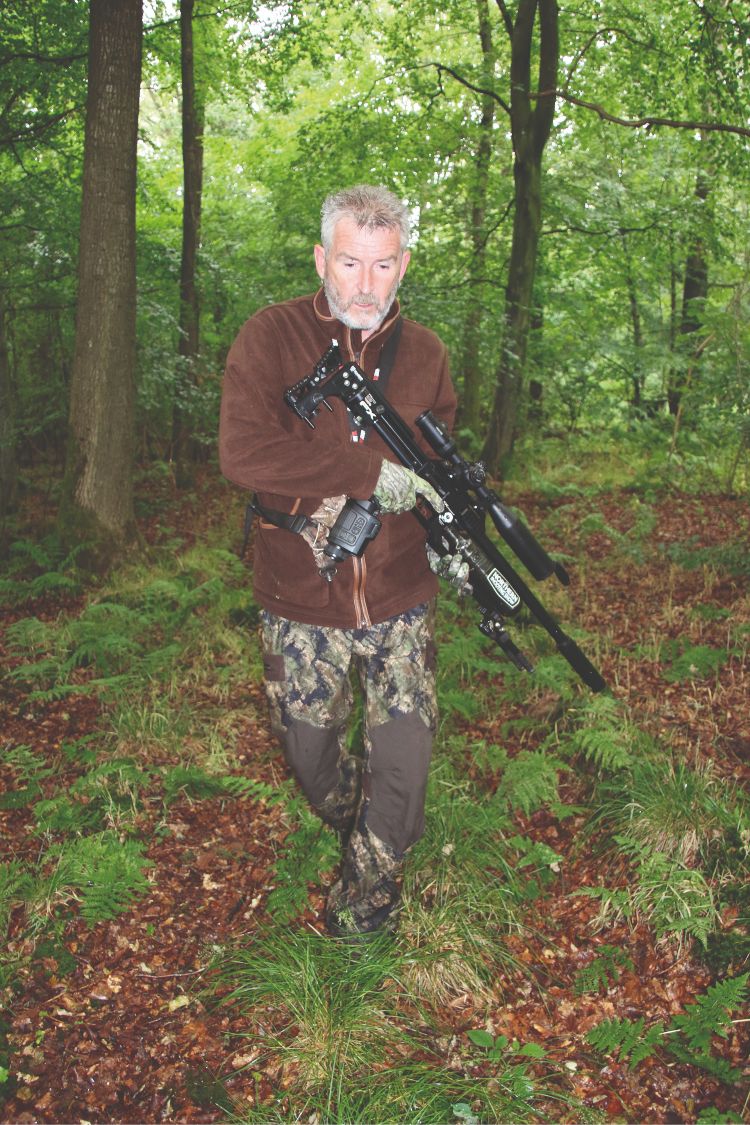 Keeping to the 'grassy knoll' to get that shot on the ferals
Keeping to the 'grassy knoll' to get that shot on the ferals
FEEDERS HARDLY TOUCHED
With that off my chest, it’s time to get back to my woodland and how I had a rude awakening when I thought I’d actually got on top of the invasive skinnies. The trail cam had shown two greys feeding from the feeders, and both looked to be youngsters, always in tandem with each other.
I turn up between 5 and 6am every morning, and then sporadically throughout the day, until around 8pm, when they slowed down, so I set out my stall at 5am, as usual, and I was confident that the youngsters would arrive on time, but by 7.30am it was a no show. I gave it another hour before breaking cover to check the feeders, and then it soon became apparent that they had changed their feeding habits – the feeders had hardly been touched, but all the scatter feed had been taken.
Now, this could easily be down to other wildlife such as songbirds, badgers and even deer, which all frequent the clearing where the feeders are set up, but my gut feeling was that they were now taking more natural food than was available, such as the beech nuts or ‘mast’ as it is better known. There are plenty of beech trees here in this woodland, and the cycle of fruiting looks to be a good one this year. The mast is somewhat advanced for the time of year and already has turned brownish with many shells opening already. I checked the upper branches, and the ground below actually showed plenty of split shells with the nut removed. It looked like the skinnies were on it already, so it was back to the feed area and some liberal scatter feeding, mainly around a tree stump that was easily overlooked from the hide. The mix contained; monkey nuts, peanuts, sunflower seeds, with a bit of maize for colour to attract other feeders such as pheasants, which would be noticed by the target species greys and give them added confidence to feed freely. I then left the area to come back for an early evening air attack, and as I headed back to the truck, I spread more loose feed along the track, hoping that the now ground-feeding skinnies would take advantage of it, and provide another opportunity for the conservation work.
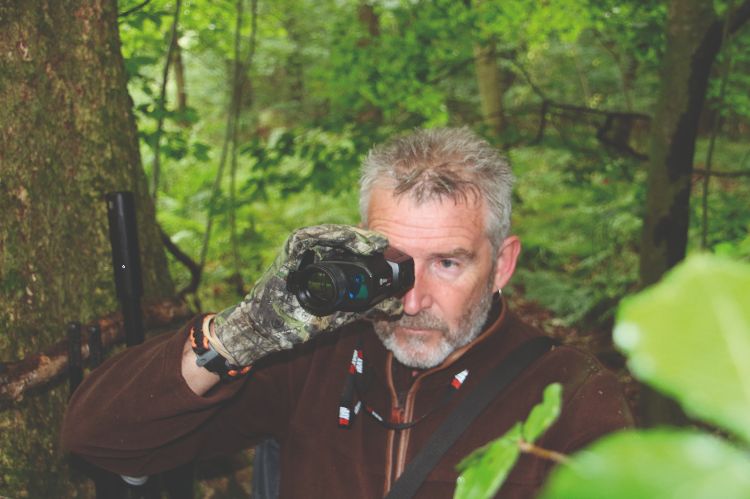 It didn't take too long before I spied the skinnies
It didn't take too long before I spied the skinnies
ROUTE TO THE HIDE
I’d been clock watching for what felt like an age and I could wait no more, so with the FX Impact stowed in the truck, I was off. After parking up, my route to the hide takes me on foot through a densely wooded, pine tree area, which keeps my movement well out of sight of any skinnies that might be feeding from the track. This allows me to get a shot or two off, and I can also get into the hide without detection. The only downside is the dried-out leaves, twigs and pine cones that make it sound like you’re walking on cornflakes. Judging where to put your feet is of paramount importance because too much noise will have your quarry heading to the treetops.
Scanning with the thermal spotter all the way and stopping every 10 yards to scan again, is my way of proceeding through any wood, and it paid dividends handsomely again this time. The FHR35 Finder easily picked out a couple of heat sources some 60 yards ahead on the track, but the long grass by the side of the track prevented any positive identification, and without that, no shot should ever be taken.
I found a strip of green grass growing with the pines and used this to my advantage. My footsteps were now silent and my approach unnoticed.
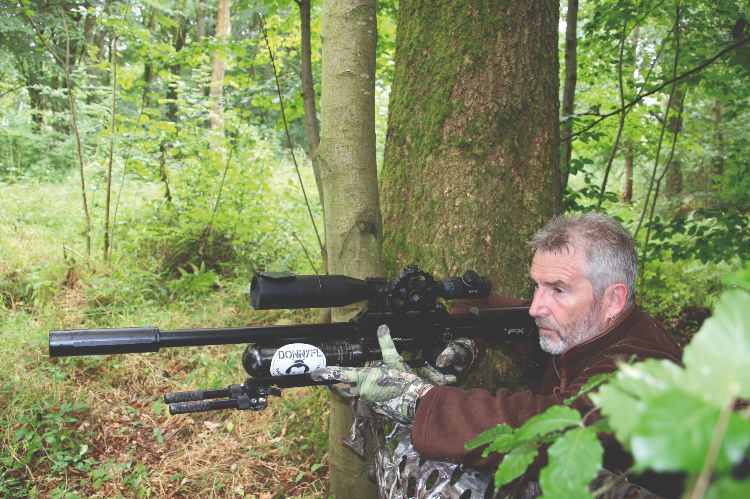 Just waiting on the skinny showing its head above the stump
Just waiting on the skinny showing its head above the stump
WHAT A SURPRISE!
I had got to within 40 yards and to my surprise, it wasn’t a couple of greys or even reds … it was a couple of feral pigeons taking the loose feed I had left. With so many pine trees I had a choice of support for the Impact, but settled for one that gave me the best view rather than a closer one. The cross hairs of the Hawke Optics scope were set between the shoulders of the nearest, and the AA Diablo finished the job off in fine style with just a couple of flaps of the feral’s wings before it expired. Number two did the usual feral thing – took flight for a second or two then dropped back, inquisitive as ever. Once more, the sights were set on the feral, but this time a clear head shot was on because it wasn’t moving its head, just staring at its buddy apparently taking a nap. Game over and a couple of bonus ferals were in the bag.
I was only around 100 yards from my hide, but still couldn’t see to where I had scatter fed. There was no chance of being heard from here, though, especially with the extremely silent Donny FL Sumo keeping the FAC crack to an acceptable minimum, and my way forward continued until I settled in the hide.
The thermal spotters are a total ‘must have’ for most, if not all pest-control activities, but sometimes, like today, it was good to sit back hidden from the world and just watch the wildlife, woodpeckers, songbirds, mice, bees – and even one very lucky jay – all gracing the scatter feed and feeders – all completely unaware of my presence, but it would have been nice to have caught up with the deer – maybe next time.
 The skinnies have turned on to the scatter feed ... change of tactics needed!
The skinnies have turned on to the scatter feed ... change of tactics needed!
ALL HELL BROKE LOOSE!
My nirvana was shattered when from behind the tree stump appeared a large adult grey, and with no hesitation began feeding on the scatter feed,. Within milliseconds, the FX was up, silently cocked and a Diablo sent out. There wasn’t even a flinch from the big male as the pellet struck home, and it lay there exactly where it fell.
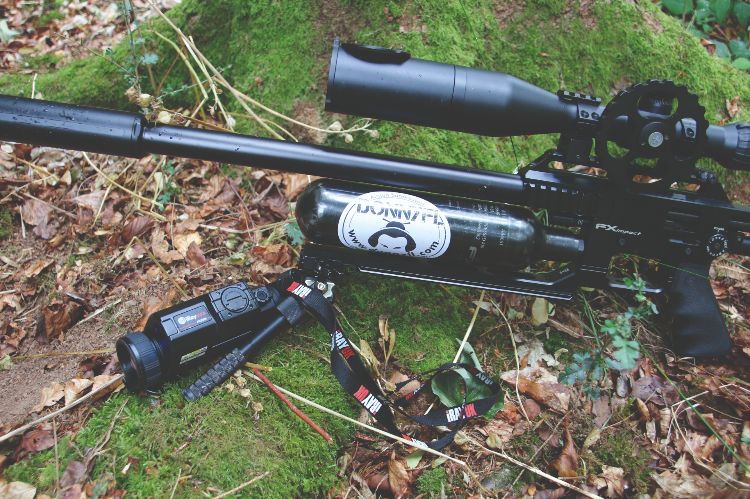 The awesome set-up; FX Impact, Hawke Optics Airmax, Donny FL Sumo and InfiRay FHR35 Finder
The awesome set-up; FX Impact, Hawke Optics Airmax, Donny FL Sumo and InfiRay FHR35 Finder
Minutes later, all hell broke loose. First up was a young female, cautiously creeping toward the fallen adult, sniffing as she drew closer. Another direct hit from the FX and it was down just behind the stump. The commotion had stirred others into coming to see what was going on; I could pick one out coming from the depths of the wood; one was coming down an adjacent beech tree, and I was getting spoiled for choice as another came sniffing the fallen pair of skinnies. Obviously, hey had all been feeding from the ground, but out of sight behind the trees and brambles. I had to take the closest one first, then wait for the next two to come into clear sight. When a plan comes together it’s a great feeling! I had three down and just felt good about the remaining two coming to Papa!
The tree descender was next up and I had to be quick Its tail was helicoptering like crazy, but a couple of seconds of patience until it settled long enough for the shot paid off, and the unmistakeable crack of pellet hitting skull reported another direct and humane kill. The last one was somewhat different. It had been coming in nicely, but once the pandemonium started it halted its progress and hung about in the canopy, giving me no clear shot and only just being able to spot it with the thermal. I decided to wait until hunger and curiosity got the better of it. It took just under an hour of patience, but sure enough, it started moving forward toward a branch overhanging the stump, and as if it had been choreographed, a heart/lung shot brought it down to earth with a thump, believe it or not, perfectly into the bracken at the side of the tree stump. ‘Man alive! – that’s five’, and I thought I was down to the last two. I had spent a good morning with nothing to show for it, but after a little investigation and some advance preparation I had taken five in around a couple of hours – plus a couple of bonus ferals.
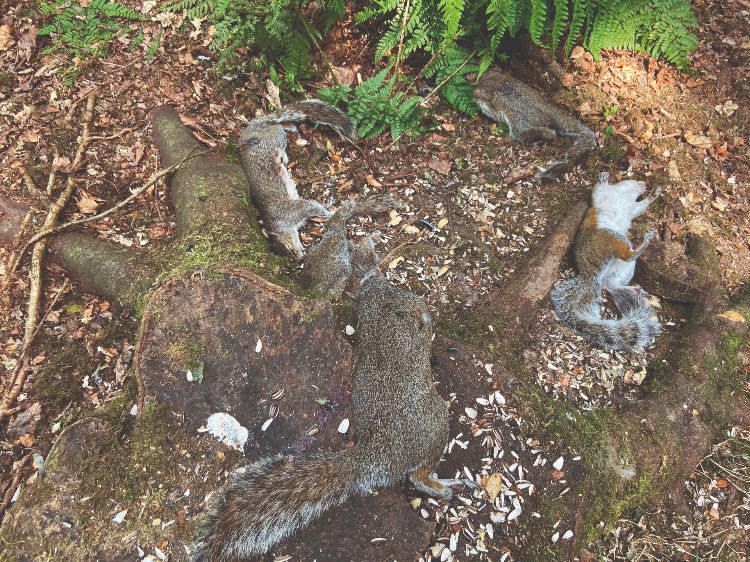 Man alive, another five!
Man alive, another five!
I have now set up another feed area at the back end of the wood with trail cameras on duty, so maybe the next article will read… ‘It’s No Fix – Another Six’, but whatever the title, the good work continues.